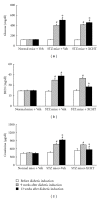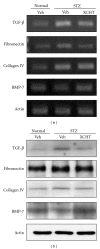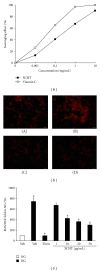Renal protective effect of xiao-chai-hu-tang on diabetic nephropathy of type 1-diabetic mice
- PMID: 22474533
- PMCID: PMC3310293
- DOI: 10.1155/2012/984024
Renal protective effect of xiao-chai-hu-tang on diabetic nephropathy of type 1-diabetic mice
Abstract
Xiao-Chai-Hu-Tang (XCHT), a traditional Chinese medicine formula consisting of seven medicinal plants, is used in the treatment of various diseases. We show here that XCHT could protect type-1 diabetic mice against diabetic nephropathy, using streptozotocin (STZ)-induced diabetic mice and high-glucose (HG)-exposed rat mesangial cell (RMC) as models. Following 4 weeks of oral administration with XCHT, renal functions and renal hypertrophy significantly improved in the STZ-diabetic mice, while serum glucose was only moderately reduced compared to vehicle treatment. Treatment with XCHT in the STZ-diabetic mice and HG-exposed RMC resulted in a decrease in expression levels of TGF-β1, fibronectin, and collagen IV, with concomitant increase in BMP-7 expression. Data from DPPH assay, DHE stain, and CM-H(2)DCFDA analysis indicated that XCHT could scavenge free radicals and inhibit high-glucose-induced ROS in RMCs. Taken together, these results suggest that treatment with XCHT can improve renal functions in STZ-diabetic mice, an effect that is potentially mediated through decreasing oxidative stress and production of TGF-β1, fibronectin, and collagen IV in the kidney during development of diabetic nephropathy. XCHT, therefore merits further investigation for application to improve renal functions in diabetic disorders.
Figures






Similar articles
-
Molecular mechanisms of the Xiao-chai-hu-tang on chronic stress-induced colorectal cancer growth based on an integrated network pharmacology and RNA sequencing approach with experimental validation.BMC Complement Med Ther. 2025 Apr 12;25(1):135. doi: 10.1186/s12906-025-04860-8. BMC Complement Med Ther. 2025. PMID: 40221743 Free PMC article.
-
Reduced beta 2 glycoprotein I improves diabetic nephropathy via inhibiting TGF-β1-p38 MAPK pathway.Int J Clin Exp Pathol. 2015 Mar 1;8(3):2321-33. eCollection 2015. Int J Clin Exp Pathol. 2015. PMID: 26045739 Free PMC article.
-
Xiao-Chai-Hu-Tang ameliorates tumor growth in cancer comorbid depressive symptoms via modulating gut microbiota-mediated TLR4/MyD88/NF-κB signaling pathway.Phytomedicine. 2021 Jul 15;88:153606. doi: 10.1016/j.phymed.2021.153606. Epub 2021 May 24. Phytomedicine. 2021. PMID: 34111616 Clinical Trial.
-
Xiao Chai Hu Tang, a herbal medicine, for chronic hepatitis B.Cochrane Database Syst Rev. 2019 Nov 7;2019(11):CD013090. doi: 10.1002/14651858.CD013090.pub2. Cochrane Database Syst Rev. 2019. PMID: 31697415 Free PMC article.
-
Xiao Chai Hu Tang for Peptic Ulcers: A Systematic Review and Meta-Analysis of Randomized Controlled Trials.Evid Based Complement Alternat Med. 2021 Apr 29;2021:6693677. doi: 10.1155/2021/6693677. eCollection 2021. Evid Based Complement Alternat Med. 2021. PMID: 34012475 Free PMC article. Review.
Cited by
-
Hu-Lu-Ba-Wan Attenuates Diabetic Nephropathy in Type 2 Diabetic Rats through PKC- α /NADPH Oxidase Signaling Pathway.Evid Based Complement Alternat Med. 2013;2013:504642. doi: 10.1155/2013/504642. Epub 2013 Jun 25. Evid Based Complement Alternat Med. 2013. PMID: 23878600 Free PMC article.
-
Antidiabetic and renoprotective effects of Cladophora glomerata Kützing extract in experimental type 2 diabetic rats: a potential nutraceutical product for diabetic nephropathy.J Diabetes Res. 2015;2015:320167. doi: 10.1155/2015/320167. Epub 2015 Mar 26. J Diabetes Res. 2015. PMID: 25883984 Free PMC article.
-
Pharmacokinetic interactions of herbal medicines for the treatment of chronic hepatitis.J Food Drug Anal. 2017 Apr;25(2):209-218. doi: 10.1016/j.jfda.2016.11.010. Epub 2016 Dec 22. J Food Drug Anal. 2017. PMID: 28911662 Free PMC article. Review.
-
Chinese medicines in the treatment of experimental diabetic nephropathy.Chin Med. 2016 Feb 24;11:6. doi: 10.1186/s13020-016-0075-z. eCollection 2016. Chin Med. 2016. PMID: 26913057 Free PMC article.
-
Review of Herbal Traditional Chinese Medicine for the Treatment of Diabetic Nephropathy.J Diabetes Res. 2016;2016:5749857. doi: 10.1155/2016/5749857. Epub 2015 Nov 15. J Diabetes Res. 2016. PMID: 26649322 Free PMC article. Review.
References
-
- Schena FP, Gesualdo L. Pathogenetic mechanisms of diabetic nephropathy. Journal of the American Society of Nephrology. 2005;16(3, supplement):S30–S33. - PubMed
-
- Rossing P. Diabetic nephropathy: worldwide epidemic and effects of current treatment on natural history. Current Diabetes Reports. 2006;6(6):479–483. - PubMed
-
- Bailey J. ACE inhibitors vs. ARBs for patients with diabetic kidney disease. American Family Physician. 2007;76(1):68–69. - PubMed
-
- Yamagishi SI, Fukami K, Ueda S, Okuda S. Molecular mechanisms of diabetic nephropathy and its therapeutic intervention. Current Drug Targets. 2007;8(8):952–959. - PubMed
-
- LeRoith D, Rayfield EJ. The benefits of tight glycemic control in type 2 diabetes mellitus. Clinical Cornerstone. 2007;8(7):S19–S29. - PubMed
LinkOut - more resources
Full Text Sources

